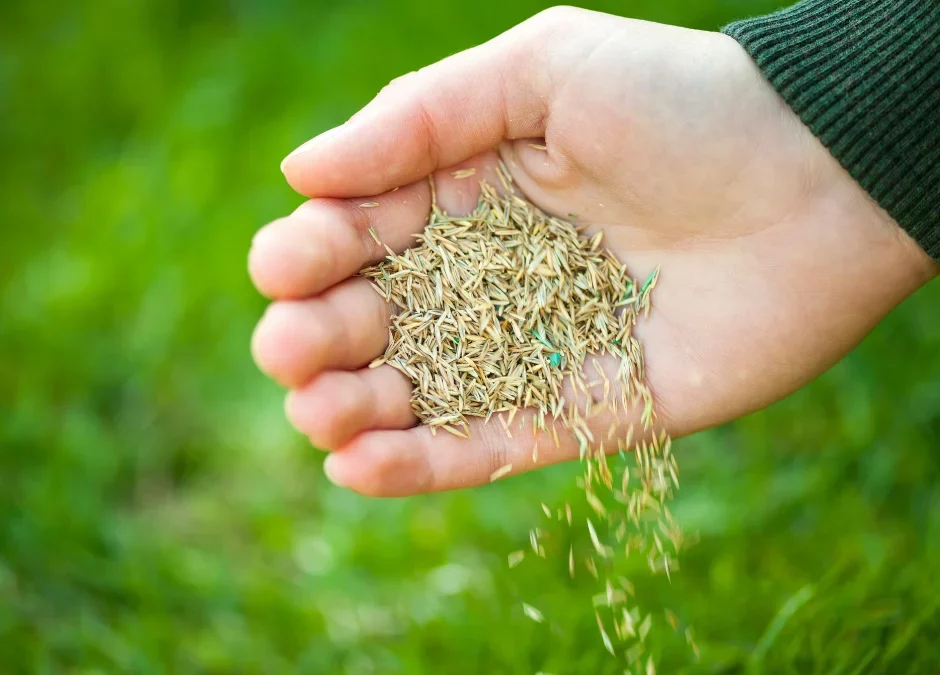The beauty of your property lies in the green spaces. It soothes the eyes, provides a refreshing change, and adds life to your property by creating a new ecosystem.
However, if you don’t take care of the lawn correctly, it can wear out or look old. If this happens, we recommend you revive the lawn through overseeding.
Not everyone is familiar with this lawn care technique, and if you aren’t either, you have come to the right place.
This guide will discuss what is overseeding, how to oversee a lawn, and much more.
What is Overseeding?
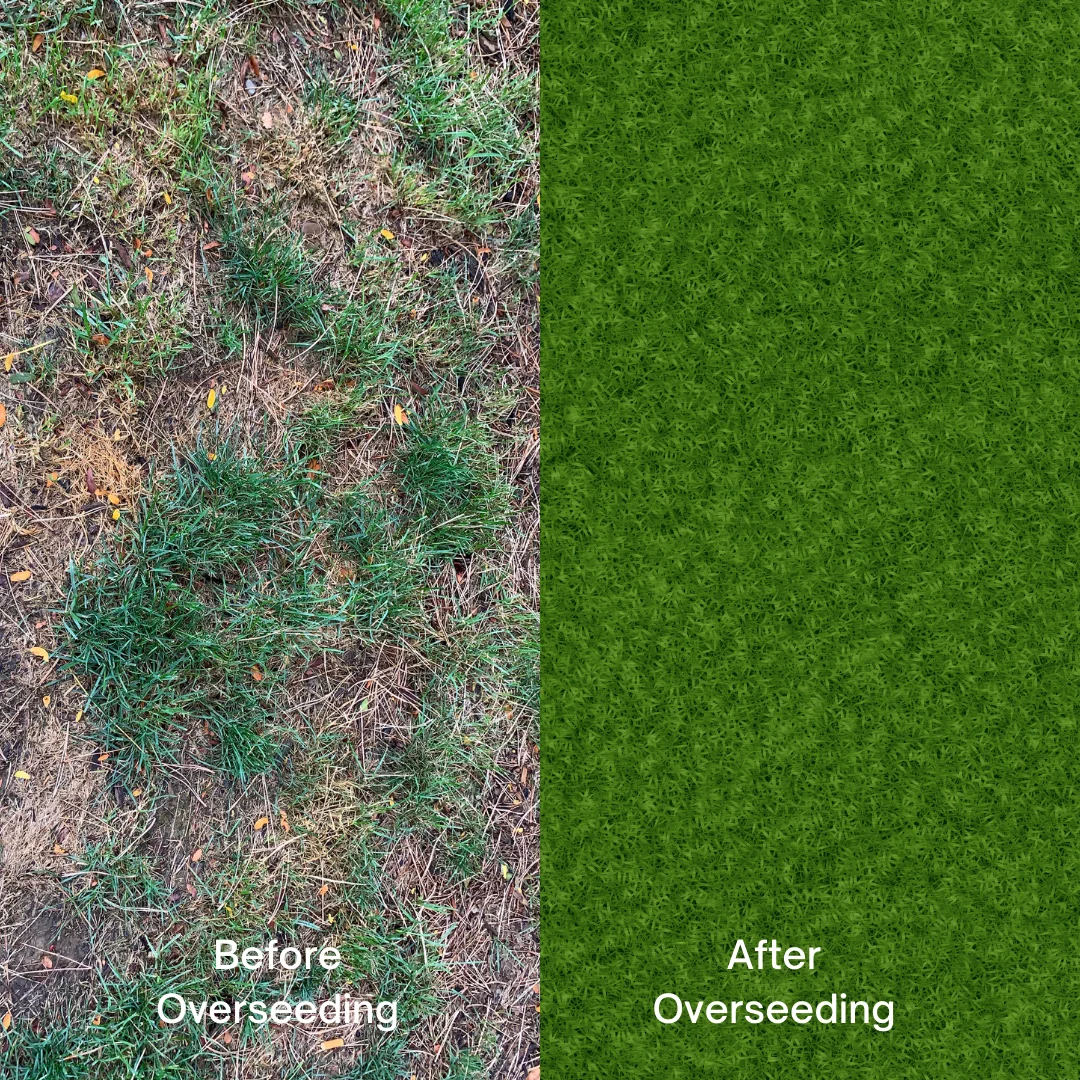
Overseeding a lawn is when you spread new grass seeds over the existing lawn to make the grass thick and fill the bare patches. Remember that you don’t have to tear your soil to overseed it in this way.
Instead, you can just add the seeds on top of your existing lawn. It will introduce more grass varieties, make the lawn thicker, and add even more colour to your lawn.
Even if your lawn is insect or disease-prone, then you can fix this issue through the power of overseeding.
Advantages of Overseeding a Lawn
Now that you know what is overseeding, you might wonder about the reasons you should be doing it.
There are many advantages to overseeding your lawn, and some of them include the following:
- It thickens the lawn
- Improves the appearance and health of the lawn
- The lawn will be in a much better position to resist damage from diseases, insects, droughts, and more
- Keeps the lawn green even when it is winter
- It will stay greener for a long time
So, if you want to reap any of these advantages, then we recommend overseeding the lawn for a fresher and healthier lawn.
How to Overseed a Lawn: A Step-by-Step Guide
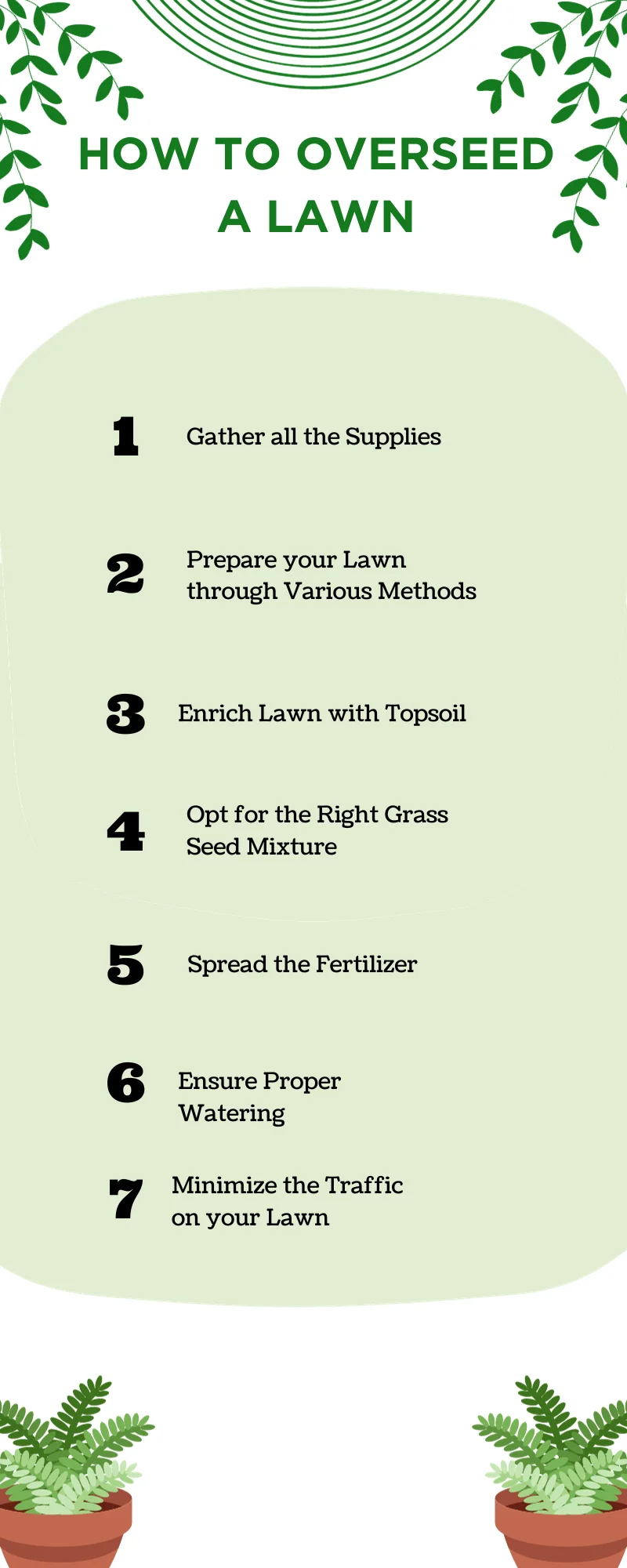
It is crucial to understand what is overseeding and its advantages so you can begin your journey on the right foot. To get the most out of overseeding, you must learn how to overseed a lawn the right way.
Our lawn care experts have reviewed all the steps to ensure you can overseed your lawn perfectly:
1. Gather all the Supplies
The first thing you need to do is gather all the important supplies to begin overseeding the lawn. We recommend you keep the following tools and equipment with you:
- Rake
- Grass seeds
- Lawn
- Topsoil
- Lawn fertilizer
- Dethatcher
If you are used to taking care of your lawn and having a lawn care schedule, then we are sure you will have this equipment with you. If not, you can always purchase it from your nearest hardware or gardening store.
2. Prepare your Lawn through Various Methods
It is vital you prepare your lawn when learning how to overseed a lawn. That is because seed germination requires the seed to be in good contact with the soil.
Here are some methods you can follow to prepare your lawn for the overseeding process:
- Cut the grass short by keeping your lawn mower on its lowest setting
- Conduct a soil test on your lawn to determine pH levels
- Remove thatch and dead grass from your lawn
- Aerate the lawn by poking holes in the soil using a core aerator (only do this if you haven’t aerated your lawn in a year)
- Use the rake to remove any debris from your lawn, such as twigs, leaves, grass clippings, and more
These are the top four methods that will help you prepare your lawn for overseeding. Your lawn will be ready for the next steps in the overseeding process.
3. Enrich Lawn with Topsoil
After you have adequately prepared your lawn, it is time to enrich it with some topsoil. A topsoil enrichment is a mixture of composts full of nutrients that will help the new grass to begin growing fast and thick.
We recommend you add a topsoil layer to your lawn by using a fertilizer spreader. As a general rule of thumb, the topsoil needs to be a quarter-inch thick on your existing lawn.
An important note to remember is that some grass seeds will already have this topsoil. If you are using such seeds, then you don’t need to follow this step.
4. Opt for the Right Grass Seed Mixture
Choosing the grass seed mixture is perhaps the most important decision when you learn how to overseed a lawn. You will need to know your grass type before you select the grass seed for optimal results.
The key is to utilize grass seeds that are already compatible with the grass growing in the yard. After that, you can spread the grass seeds mixture using the fertilizer spreader and make sure you walk it in rows on your lawn.
It is crucial to spread the grass seeds in the same pattern you have mowed. If you are confused about the amount of grass seeds to use or how to spread them, we recommend you check the packaging to look at the instructions and follow them.
5. Spread the Fertilizer
Once you have spread the grass seeds on your lawn, it is time to fertilize the lawn again for the best results. You have to add the fertilizer wherever you add the seed.
You must also select the right fertilizer for this process. For example, if you are dealing with new grass, then your best bet is to use a starter fertilizer.
Such a fertilizer will help the seeds to have strong roots and grow quickly. Many people also opt for weed and feed combinations when they are spreading the fertilizer.
However, the components present in such combinations will hinder your new grass from growing after overseeding. On the other hand, if your grass seeds mixture already has fertilizer, then you don’t need to follow this step for additional fertilization, as that is not required.
6. Ensure Proper Watering
Anyone who wants to learn how to overseed a lawn and what is overseeding needs to water it properly till the very end. This means you have to generously water your lawn after you have fertilized it so that the soil can remain moist and new grass can begin growing from it.
We recommend you water in the morning so that the water is not evaporated because of the sun. Early morning is the best time to water your lawn.
On the other hand, make sure you don’t overwater your grass. A few signs of overwatering grass include the following:
- Puddles in your lawn
- Discolored grass
- Mushy soil
- And too many bare patches or pots on your lawn
If you notice any of these signs on your lawn, then we recommend you reduce the watering. It will help the grass to grow in the best way possible.
7. Minimize the Traffic on your Lawn till the New Grass Grows
Finally, it is time for you to wait for the new grass to grow after you are done learning how to overseed a lawn. It is crucial that you reduce traffic on the lawn until your grass is between one and two inches tall.
Don’t be in a hurry to mow the lawn as you watch the new grass grow. Instead, you must wait to mow the lawn till the new grass comes to the same height as the grass already present on your lawn.
Once that happens, we recommend you follow your normal lawn care schedule. It will guarantee that your lawn looks great all year round.
How to Care for Your Lawn after Overseeding
Knowing what is overseeding and how to overseed a lawn is good, but you also need to care for your lawn after the overseeding process.
Most of the time, the new grass will begin sprouting within a week of overseeding. A full lawn will take at least eight weeks to emerge.
During this time, it is important to care for your lawn adequately to see beautiful results. Let’s review some important things you can do to care for your lawn after overseeding:
- Water your grass deeply immediately after overseeding
- For the first ten to fourteen days, water lightly daily to ensure that the first inch of soil is soaked
- After the seeds have begun germinating, you must water less frequently but ensure that the water is penetrated into the soil
- Once the grass is grown, it is time to follow the adequate water recommendations for the grass you have planted
It will take a lot of patience and proper care for the grass to grow new. The key is to follow the right overseeding steps to ensure that the grass responds properly to your methods and grows thick and fast.
How Often Should You Overseed Your Lawn?
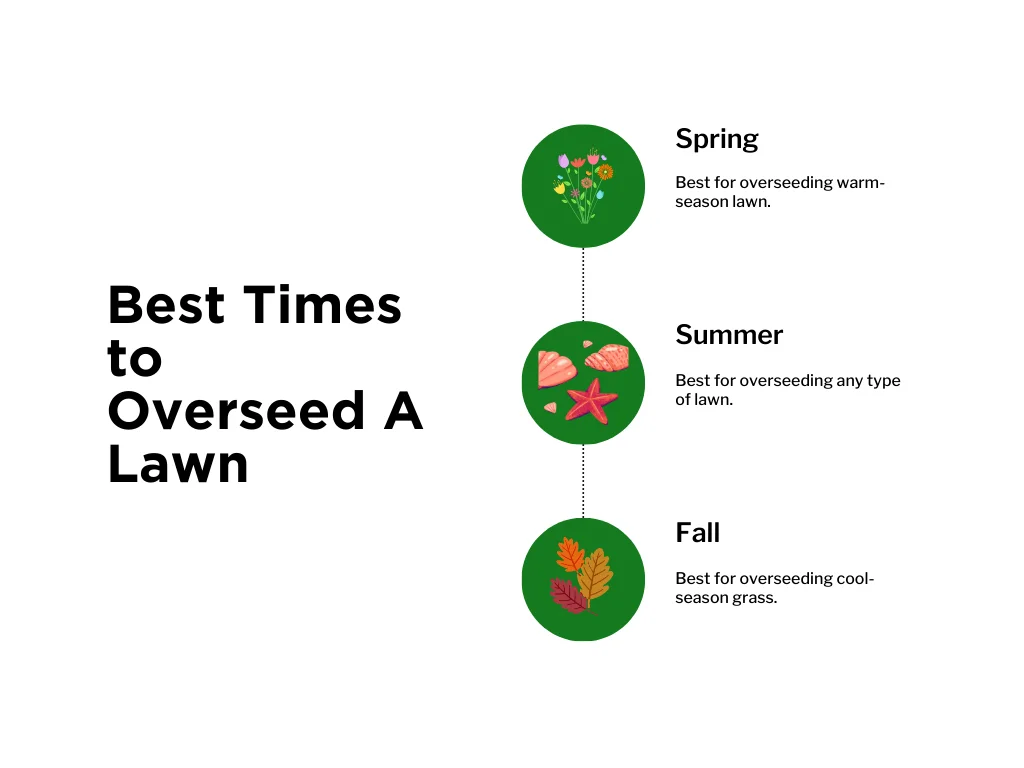
How often you should overseed your lawn will depend on the type of grass and lawn you have. For example, some lawns incur disease and drought a lot that leaves them thin and bare, and you will need to overseed them at least once in a year for optimal growth.
On the other hand, some lawns are highly resilient, and you will not need to overseed them a lot. You will have to overseed these lawns once every few years.
The key is to keep an eye on your lawn and determine when it needs overseeding.
We recommend that the best time to overseed your lawn is during the spring or fall. That is because grass is the most active during those times and grows well.
However, the active growth period of your grass will depend on the season and grass type. We have broken down how you can overseed your lawn during different times of the year:
How to Overseed a Lawn in Spring
If you have a warm-season lawn, then you will need similar grass seeds. The best time to overseed such lawn is during the spring time.
The ideal soil temperature should be between seventy and ninety degrees to begin your overseeding process. Once you have begun overseeding such a lawn in the spring, it will begin growing actively and soon start thriving.
If you don’t know whether your grass is warm-season or cool-season, then be sure to do your research. However, some common types of warm-season grass includes the following:
- Augustine
- Centipede grass
- Zoysia grass
- Bermuda grass
- Tall fescue
- Bahia grass
There are many more such grasses, and if you don’t know which one yours is, then we recommend you get an expert’s opinion.
How to Overseed a Lawn in Summer
Another time you can overseed your lawn is during late summer. This is the best time for some lawns because the temperatures of the atmosphere and soil are good for seed germination and growth.
On the other hand, you don’t need to worry about weeds during this time because the environment for the grass is ideal to grow and develop properly. You can overseed a lawn in summer in the same way as any other time, but it is good to understand the soil and temperature conditions before you do.
Such knowledge will allow you to start the overseeding journey on the right foot.
How to Overseed a Lawn in Fall
Fall is a great season to overseed cool-season grass. These grass will usually grow where the cold season is much more prominent in Canada.
Some of the most common cool-season grass in Canadian homes includes the following:
- Ryegrass
- Red fescue
- Kentucky bluegrass
- And more
These grasses are usually dormant in the summer, and they need proper irrigation at all times.
We recommend you overseed the cool-season grass at least forty-five days before you expect the first frost in the region. Besides that, the soil temperature must be between fifty and sixty-five degrees.
Utilize a soil thermometer to check the temperature and then begin the overseeding process. Once you do, you will soon have thick grass in your lawn in fall.
Aeration and Overseeding: What Will Work Best for Your Lawn?
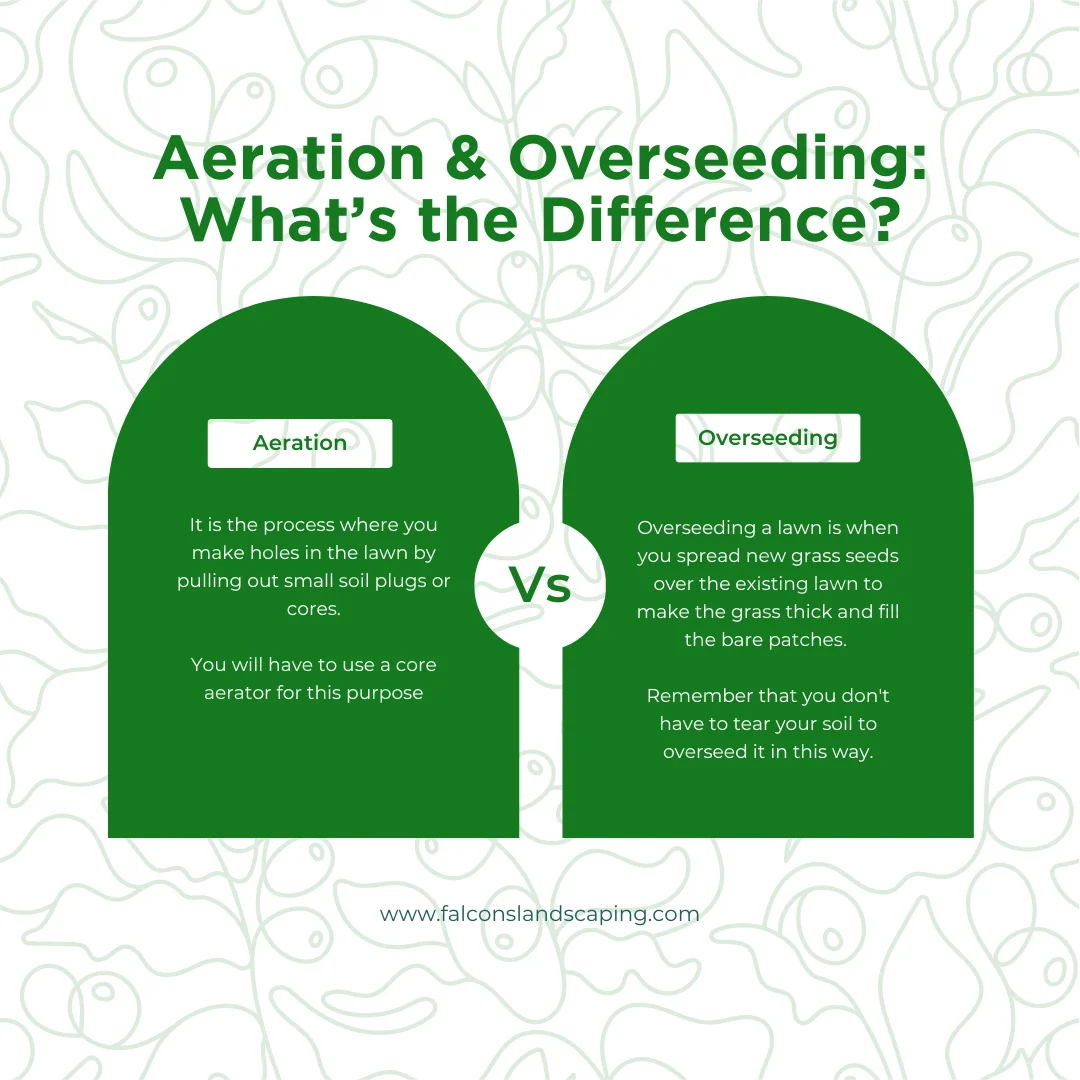
Many people get confused between aeration and overseeding because they sound one and the same. However, there is an important difference between the two.
We have already discussed overseeding, so let’s understand what aeration is. It is the process where you make holes in the lawn by pulling out small soil plugs or cores.
You will have to use a core aerator for this purpose, as it will help you do this task more easily.
The purpose of this process is to ensure that the soil gets more nutrients, air, and water to the roots.
As the aeration process works its magic, the grass and roots will grow thicker and healthier. Many people use aeration and overseeding together for the best results.
Both will work the best with one another to create a healthier lawn on your property. So, be sure to learn how to do aeration and overseeding for a beautiful lawn.
FAQs
What is the best time to overseed your lawn?
Spring and fall are the two best times to overseed your lawn. However, we recommend overseeding the lawn in the fall. It will allow the seeds to germinate quicker, and the weed growth will have tapered off too – making it the ideal environment for overseeding.
What is the best grass for overseeding?
Overseeding works with almost all types of grass. However, the best grass for you will depend on the region, climate, atmosphere, soil quality, and other factors.
What fertilizer to use with overseeding?
We recommend using a nitrogen fertilizer for your lawn space. It will maintain the lawn and ensure that the grass grows healthy and thick.
What is the quickest-growing grass seed?
Perennial Ryegrass is one of the top types of grass that grows the quickest. So, if you want grass that grows fast, we recommend you opt for this one. It will take approximately ten days for this grass to begin sprouting on your lawn.
Final Thoughts
That was your complete guide to understanding what is overseeding and how to overseed a lawn. Overseeding a lawn has many benefits, and we recommend doing this from time to time, depending on what type of lawn you have,
On the other hand, if you think this process is too much for you, then you can always contact our lawn care experts. Falcons Landscaping will be more than happy to help you out with aeration, fertilization, and overseeding needs.

